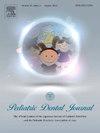A retrospective study of the effect of birth status on the acquisition time of feeding function
IF 0.6
Q4 DENTISTRY, ORAL SURGERY & MEDICINE
引用次数: 0
Abstract
Objective
Low birthweight infants (LBW) are known to have a significantly high complication rate, and mortality rate, and many of them are admitted to the Neonatal Intensive Care Unit (NICU). The purpose of this study is to assess LBW using a feeding function assessment to determine the appropriate time of acquisition of feeding function for effective support.
Methods
The subjects were 134 children, 84 LBW, 50 normal birth weight (NBW), up to 12 years old who had received multiple feeding guidance at Meikai University Hospital and a certain medical center from 2010 to 2021. The subjects were divided into two groups: LBW and NBW, and the developmental status of feeding function was examined retrospectively. From the medical records, we investigated feeding function, motor function, number of weeks of gestation, NICU admission, and tube feeding and its duration, and use of public services.
Results
Significant differences were found in the time of oral intake preparation, time of swallowing function acquisition, time of mashing function acquisition, time of self-feeding preparation, time of fixed neck, rolling over, sitting up without support, and pulling up to stand. The factor influencing both feeding function and motor function was the number of weeks of gestation, followed by public services. The common factor influencing feeding function was NICU admission, and gender was also influential during the time of preparation for self-feeding.
Conclusion
These results suggest that it is effective to provide support during the time of swallowing function acquisition.
出生状况对哺乳功能获得时间影响的回顾性研究
目的低出生体重儿(LBW)的并发症发生率和死亡率都非常高,其中很多都住进了新生儿重症监护病房(NICU)。本研究的目的是通过进食功能评估来评估体重,以确定获得有效支持的进食功能的适当时间。方法选取2010 - 2021年在梅开大学附属医院及某医疗中心接受多次喂养指导的12岁以下儿童134例,体重84例,正常出生体重(NBW) 50例。将实验对象分为低体重组和中等体重组,回顾性观察进食功能发育状况。从医疗记录中,我们调查了喂养功能,运动功能,妊娠周数,NICU入院,管饲及其持续时间,以及公共服务的使用情况。结果两组患者在口腔摄食准备时间、吞咽功能获得时间、咀嚼功能获得时间、自行进食准备时间、固定颈部时间、翻身时间、无支撑坐起时间、拉起站立时间等方面均存在显著差异。影响喂养功能和运动功能的因素均为妊娠周数,其次为公共服务。影响喂养功能的常见因素为新生儿重症监护病房入住情况,自食准备阶段性别也有影响。结论在吞咽功能获得期给予支持是有效的。
本文章由计算机程序翻译,如有差异,请以英文原文为准。
求助全文
约1分钟内获得全文
求助全文
来源期刊

Pediatric Dental Journal
DENTISTRY, ORAL SURGERY & MEDICINE-
CiteScore
1.40
自引率
0.00%
发文量
24
审稿时长
26 days
 求助内容:
求助内容: 应助结果提醒方式:
应助结果提醒方式:


